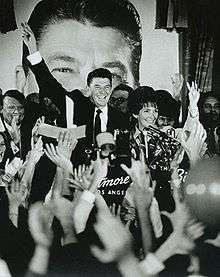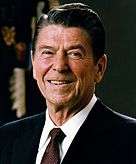Governorship of Ronald Reagan


Ronald Reagan was the Governor of California for two terms, first in 1967 and then re-elected in 1971. He left office in 1975, declining to run for a third term. Robert Finch, Edwin Reinecke, and John L. Harmer served as lieutenant governors over the course of his governorship.
Nomination and election
California Republicans were impressed with Reagan's political views and charisma after his "A Time for Choosing" speech,[1] and nominated him as the Republican party candidate for Governor in 1966.[2][3]
Reagan's campaign emphasized two main themes: "to send the welfare bums back to work", and regarding burgeoning anti-war and anti-establishment student protests at UC Berkeley, "to clean up the mess at Berkeley".[4] He was elected, defeating two-term governor Edmund G. "Pat" Brown by nearly a million votes, and was sworn in on January 2, 1967 at ten minutes past midnight.[5] In 1988, Reagan explained that this time was chosen because his predecessor, Governor Brown, "had been filling up the ranks of appointments and judges" in the days before his term ended. Professor Marcello Truzzi, a sociologist at Eastern Michigan University who studied the Reagans' interest in astrology, regarded this explanation as "preposterous", as the decision to be sworn in at that odd time of day was made six weeks earlier, and was based on advice from Reagan's long-time friend, the astrologer Carroll Righter.[6]
Reagan was elected to his first term as Governor of California on November 8, 1966 with 57.65% of the vote.
First term (1967–1971)
In his first term, he froze government hiring and approved tax hikes to balance the budget.[7] Shortly after the beginning of his term, Reagan tested the presidential waters in 1968 as part of a "Stop Nixon" movement, hoping to cut into Nixon's Southern support[8] and be a compromise candidate[9] if neither Nixon nor second-place Nelson Rockefeller received enough delegates to win on the first ballot at the Republican convention. However, by the time of the convention Nixon had 692 delegate votes, 25 more than he needed to secure the nomination, followed by Rockefeller with Reagan in third place.[8]
Reagan was involved in high-profile conflicts with the protest movements of the era. On May 15, 1969, during the People's Park protests at UC Berkeley, Reagan sent the California Highway Patrol and other officers to quell the protests, in an incident that became known as "Bloody Thursday".[10][11] Reagan then called out 2,200 state National Guard troops to occupy the city of Berkeley for two weeks in order to crack down on the protesters.[10] When the Symbionese Liberation Army kidnapped Patty Hearst in Berkeley and demanded the distribution of food to the poor, Reagan joked, "It's just too bad we can't have an epidemic of botulism."[12]
Early in 1967, the national debate on abortion was beginning. Democratic California state senator Anthony Beilenson introduced the "Therapeutic Abortion Act", in an effort to reduce the number of "back-room abortions" performed in California.[10] The State Legislature sent the bill to Reagan's desk where, after several days of indecision, he signed it.[13] About two million abortions would be performed as a result, mostly because of a provision in the bill allowing abortions for the well-being of the mother.[13] Reagan had been in office for only four months when he signed the bill, and stated that had he been more experienced as governor, it would not have been signed. After he recognized what he called the "consequences" of the bill, he announced that he was pro-life.[13] He maintained that position later in his political career, writing extensively about abortion.[14]
Reagan made addresses to people which were similar to Franklin Delano Roosevelt's fireside chats.
Second term (1971–1975)
An unsuccessful attempt to recall Reagan in 1968[15] was supported by senior citizens, educators, and organized labor.[16] Reagan was re-elected in 1970, defeating "Big Daddy" Jesse M. Unruh on November 3 with 52.85% of the vote. He chose not to seek a third term in the following election cycle. One of Reagan's greatest frustrations in office concerned capital punishment, which he strongly supported.[17] His efforts to enforce the state's laws in this area were thwarted when the Supreme Court of California issued its People v. Anderson decision, which invalidated all death sentences issued in California prior to 1972, though the decision was later overturned by a constitutional amendment. The only execution during Reagan's governorship was on April 12, 1967, when Aaron Mitchell's sentence was carried out by the state in San Quentin's gas chamber.[18]
Reagan wrote that the tax increase, in combination with the spending cuts, had created revenue surpluses, so he gave four tax rebates to the people, which he claimed to have amounted to over $5 billion.
During his Governorship, Reagan was sent to many nations by Nixon as a special envoy.
Governorship legacy
Reagan's terms as governor helped to shape the policies he would pursue in his later political career as president. By campaigning on a platform of sending "the welfare bums back to work", he spoke out against the idea of the welfare state. He also strongly advocated the Republican ideal of less government regulation of the economy, including that of undue federal taxation.[19]
Citations
- ↑ . (2006). "Governor Ronald Reagan". Sacramento: California State Library. Archived from the original on April 29, 2007. Retrieved March 21, 2007.
- ↑ Gerard J. De Groot, "‘A Goddamned Electable Person’: The 1966 California Gubernatorial Campaign of Ronald Reagan." History 82#267 (1997) pp: 429-448.
- ↑ Totton J. Anderson and Eugene C. Lee, "The 1966 Election in California," Western Political Quarterly (1967) 20#2 pp. 535-554 in JSTOR
- ↑ Kahn, Jeffery (June 8, 2004). "Ronald Reagan launched political career using the Berkeley campus as a target". UC Berkeley News. Retrieved March 30, 2007.
- ↑ Greenberg, Carl (November 24, 1966). "Reagan announces he'll name 'task force' of women". Los Angeles Times. p. 3. Retrieved January 12, 2014.
Other developments Wednesday included: Reagan and Finch will be sworn into office at a private ceremony attended only by members of their families and the press at 12:10 a.m. Jan. 2 in the rotunda of the Capitol in Sacramento… Reagan's executive assistant Philip M. Battaglia, said the oath-taking ceremony was decided on for 10 minutes after midnight because Jan. 2 is a holiday and many persons will want to attend the Rose Bowl game and other events. Reagan interjected: 'I don't say I'm a pessimist or anything, but anythings can happen.' Traditionally governors have taken the oath at noon in the Assembly chamber in the presence of the new Legislature.
AP (November 25, 1966). "Brown and family thankful for '8 wonderful years' in capital". Los Angeles Times. p. 3. Retrieved January 12, 2014.Turning to the question of his successor Brown called 'peculiar' Gov.-elect Ronald Reagan's decision to be sworn into office at 12:10 a.m. Jan. 2. 'I just can't understand it,' he said. 'My only guess is it's because he believes in astrology. I understand he does. I think it's peculiar.'
Zeman, Ray (November 26, 1966). "Reagan aide deplores lame-duck job filling; says Governor-elect would like to be consulted on naming judges and others". Los Angeles Times. p. 3. Retrieved January 12, 2014.Asked about Gov. Brown's guess that Reagan decided to be sworn in at 12:10 a.m. because he believes in astrology, Battaglia said: 'Mr. Reagan told me he considers irresponsible statements such as this unfortunate. He does not believe in stars, does not consult them and doesn't intend to have star-gazers in his administration.' He explained that the swearing-in of Reagan and Lt. Gov. Robert H. Finch was set for a few minutes after midnight because of 'public interest and convenience.'
UPI (December 29, 1966). "Reagan sworn in early in a mixup. Signs paper and takes oath six days in advance". 'The New York Times. p. 14. Retrieved January 12, 2014.Mr. Jordan said that because of this Mr. Reagan would become Governor at 12:01 A.M. Monday even if he did not go through with his plans to take the oath again at that time. The Secretary of State, like Mr. Reagan a Republican, said the post-midnight oath on Monday would be 'just a ceremony.'
Davies, Lawrence E. (January 3, 1967). "Three Republican governors take oath of office. Reagan sworn in; urges coordination of many agencies". The New York Times. p. 1. Retrieved January 12, 2014.Hardly more than 12 hours after his oath-taking Governor Reagan briefly addressed a joint session of the Assembly and Senate
- ↑ Roberts, Steven V. (May 4, 1988). "White House confirms Reagans follow astrology, up to a point". The New York Times. p. A1. Retrieved January 12, 2014.
Roberts, Steven V. (May 18, 1988). "Not a slave to the zodiac, Reagan says". The New York Times. p. A22. Retrieved June 7, 2009. - ↑ Cannon (2001), p. 47.
- 1 2 Fischer, Klaus P. (2006). America in White, Black, and Gray: The Stormy 1960s. New York: Continuum. pp. 241–243. ISBN 0-8264-1816-3.
- ↑ . (March 8, 1968). "Republicans: The new rules of play". Time. Retrieved October 16, 2007.
- 1 2 3 Cannon (2001), p. 50.
- ↑ . (February 16, 1970). "Postscript to People's Park". Time. Retrieved December 9, 2007.
- ↑ . (March 14, 1974). "Reagan raps press on botulism quote". Los Angeles Times. p. A29. Retrieved May 10, 2008.
- 1 2 3 Cannon (2001), p. 51.
- ↑ Reagan, Ronald (1984). Abortion and the Conscience of the Nation. Nashville: Thomas Nelson. ISBN 0-8407-4116-2.
- ↑ Gold, Matea (July 13, 2003). "Recall idea got its start in L.A. in 1898". Los Angeles Times. p. B1. Retrieved December 8, 2008.
- ↑ url=https://news.google.com/newspapers?nid=1129&dat=19680708&id=n51RAAAAIBAJ&sjid=e2wDAAAAIBAJ&pg=7014,1169940c
- ↑ Reagan, Ronald; Hubler, Richard G. (1965). Where's the Rest of Me?. New York: Duell, Sloan, and Pearce. OCLC 1338703.
- ↑ Seneker, Carl J. (May 1, 1967). "Governor Reagan and executive clemency". California Law Review. 55 (2): 412–418. doi:10.2307/3479351. ISSN 0008-1221. JSTOR 3479351.
- ↑ Kubarych, Roger M. (June 9, 2004). "The Reagan economic legacy". New York: Council on Foreign Relations. Retrieved August 22, 2007.
Further reading
- Anderson, Totton J. and Eugene C. Lee. "The 1966 Election in California," Western Political Quarterly (1967) 20#2 pp. 535-554 in JSTOR
- Brands, H.R. Reagan (2015) pp 148-91
- Cannon, Lou. Governor Reagan: His rise to power(PublicAffairs, 2005)
- De Groot, Gerard J. "‘A Goddamned Electable Person’: The 1966 California Gubernatorial Campaign of Ronald Reagan." History 82#267 (1997) pp: 429-448.
- Hamilton, Gary G., and Nicole Woolsey Biggart. Governor Reagan, Governor Brown: A sociology of executive power (Columbia University Press, 1984)
- Holden, Kenneth. Making of the Great Communicator: Ronald Reagan's Transformation From Actor To Governor (2013)
- Putnam, Jackson K. "Governor Reagan: A Reappraisal." California History (2006): 24-45. in JSTOR
- Reeves, Michelle. "Obey the Rules or Get Out": Ronald Reagan's 1966 Gubernatorial Campaign and the 'Trouble in Berkeley'." Southern California Quarterly (2010): 275-305. in JSTOR
- Schuparra, Kurt. Triumph of the Right: The Rise of the California Conservative Movement, 1945-1966 (ME Sharpe, 1998)
